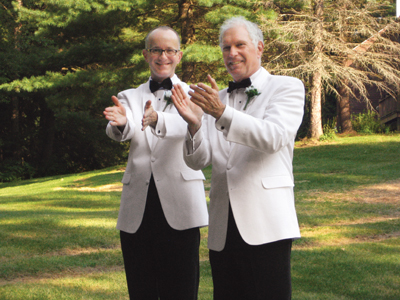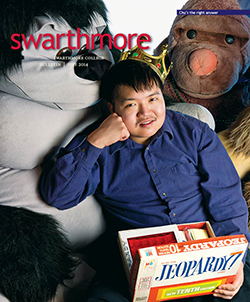A Civil Right
The named plaintiff in landmark legislation details how his state became a steppingstone to national progress toward marriage for all

Aug. 13, 2010, 10 years after the momentous Baker v. Vermont decision, Peter Harrigan (left) and Stannard Baker ’68 were married in their backyard with a church blessing to follow. Photo by Margaret Harrigan.
When my husband Peter Harrigan and I were plaintiffs in the 1997 Vermont Freedom to Marry lawsuit, press asked us: Why did you decide to do this? Our answer: Because we fell in love. After four years together, we wanted to have a legal bond joining us, and we wanted to be able to proclaim our love in front of our family and friends. Marriage is a core institution of our society, and being barred from it is akin to losing the right to vote. If anyone is excluded from a right that others have, then no one’s rights are safe. The fall of the Defense Against Marriage Act (DOMA) in June 2013 means that the benefits of marriage, in addition to the cultural and spiritual power of the word itself, is now extended on the federal level to all same-sex couples and is now the law in 19 states.
In 1996 a friend from Vermont asked me to narrate Freedom to Marry: A Green Mountain View, a 17-minute video. This experience nudged me to go home to Peter and discuss marriage. He and I quickly went from thinking of gay marriage as impossible to a strong conviction that it could happen for LGBT couples here in Vermont and that the time had come. My experience as a student at Swarthmore during a time of rising political awareness about justice, inclusion, and diversity also played a part in my journey to becoming a plaintiff.
Peter and I signed onto the lawsuit as a gay male couple with two other brave lesbian couples. Because B ranks at the top, alphabetically, I became the named plaintiff. Our case will forever be Baker v. Vermont, the Baker case, or simply Baker. The three years between 1997 and 2000, when the case was decided were difficult and exhilarating. We were buoyed by the support of the Freedom to Marry task force, the LGBT community, and our crack legal team, Susan Murray, Mary Bonauto, and Beth Robinson. Mary remains a force in many subsequent lawsuits, and Beth is now a Vermont Supreme Court justice.
During those three years, Vermonters had a conversation that was difficult and often vitriolic. Regular folks found themselves using words they’d never used before: homosexual, gay, lesbian, bisexual, transgender, same sex, etc. Some who previously had maintained a veneer of tolerance suddenly had to face their own biases. It was difficult and trying, and I had to put up my imaginary “Leviticus shield” whenever I sat in the statehouse at the house judiciary hearing as person after person testified about how evil or sinful I was. Yet Vermonters were educated, no violence happened, and Vermont moved forward. Our state was the first to legislate equal rights for same-sex couples, which included civil unions. Peter and I exercised that right in August 2000.
Our case became a major part of the foundation on which marriage victories in other states and countries were built. Due out this summer is Vermont, A State of Marriage, a documentary by Jeff Kaufman, which makes the point that Vermont was a cornerstone for all that came after.
I realize now the subconscious self-protective precautions I took as a matter of course. I’d always scan the parking areas around our home for strange cars, take a quick look at the shrubbery to see if people were concealed, and at our presentations would note how to escape the room or use a table as a barricade if needed. Perhaps the hardest thing for Peter and me was when our photo was featured on the Rev. Fred Phelps’ Westboro Baptist Church website with a caption that read “Vermont Fag Beasts.” The caption detailed all the horror that would happen to us in this life and the life hereafter. Our lawyers let us know about the Web page and told us we didn’t have to look at it or read it. At that moment, Peter and I could both feel the power and depth of their support and caring.
Despite every trying thing that happened, there were 10 examples of support. Being in a small state allowed all six of us plaintiffs to continue our lives, jobs, and roles in the community—and to remain real people. Peter and I were happy to officially marry in Vermont on Aug. 13, 2010, 10 years to the day after our civil union.
When a reporter asked last summer if waiting for the Supreme Court to overturn DOMA had been trying, I replied, “Yes, but not nearly as excruciating as waiting for the Vermont Supreme Court to rule on the Baker case.” Similarly, when Vermont in 2010 became the first state to legislate same-sex marriage, I remember the suspense of sitting in the house chamber silently counting votes that led to the override of Gov. Jim Douglas’ veto of same-sex marriage. The elation when the house succeeded in the override was amazing.
The speed with which we got to where we are now takes my breath away. After civil union legislation was enacted, reporters asked me, “How long do you think it will be until there is same-sex marriage?” Based on my knowledge of the history of interracial marriage in the United States, which took a generation to get from the first major lawsuit in California to the Supreme Court in Loving v. Virginia, I replied, “Probably a generation.” But here we are, just 14 years after the Baker decision. DOMA has been struck down, 19 states have same sex-marriage, and there is a palpable hope to extend marriage rights to all states. I am pained, however, at the peril that LGBT people face in Russia, some African countries, and other places in the world. The same zealotry exemplified by Fred Phelps has been exported from the United States. None are free until all are free!
Since the ruling on civil unions, I’ve gone forward in my work as a mental-health professional and have also been ordained as a clergy person in The Episcopal Church. As part of my church work, I’ve served on task forces working for full inclusion of LGBT people in The Episcopal Church as well as the creation of a marriage liturgy. Through the work on the bishop of Vermont’s Same-Gender Blessing Task Force, on a similar task force for the Episcopal Province of New England, and on a task force for the transnational Episcopal Church, we now have a same-sex blessing liturgy that can be used for marriage in states that allow marriage and as a spiritual church ceremony and a blessing in states that do not. This—along with approving ordination of gay bishops—was not easy for The Episcopal Church. I’m proud of my church and grateful that my wisdom and experience as a plaintiff in the Freedom to Marry lawsuit was a piece of this.
Without doubt, access to same-sex marriage strengthens our community, our society and our country. When all people have access to core institutions, we are all stronger. As LGBT folks, we have much to teach the heterosexual world about marriage. When gay people, as a group, were denied a fundamental right—as people of color were denied the vote in South Africa—the value of that thing was ever more apparent, and we stood together to fight for it.
Stannard Baker ’68, a psychotherapist who was class secretary for the Bulletin from 2007–12, lives in Shelburne Vt., with his husband, Peter Harrigan, a professor of theatre and chair of the fine arts department at St. Michael’s College.
To watch the documentary trailer Vermont, A State of Marriage, in which Stan and Peter are featured, click here
 Email This Page
Email This Page